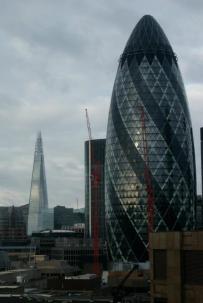I remember the moment I learned I would be joining the London Scriptwriting Study Program very well. I was sitting in a Telecomm class waiting for my professor to begin her lecture. As I had done for the past week, nearly every five minutes, I checked my email. The past few weeks, I had been clicking the refresh button of my email with the zeal of a sleep deprived and highly caffeinated loon.
I opened my email and searched my inbox, and to no surprise, I did not see the email I had long awaited. There was a well-defined fingerprint on the screen of my phone, a relic of my persistence. One last time I clicked the refresh button and was finally rewarded for my vigilance, an email from the Office of Overseas Study.
Not wanting to look desperate and lacking a complete understanding of how technology works, I waited. I felt the two-ring rule for phone calls roughly translated to two minutes with emails. Two minutes passed and I opened the email and found a beautiful opening statement: “I am pleased to notify you that you have been selected for the London Scriptwriting Overseas Study Program for the summer 2012 term.”
I soaked the moment in, covering my mouth to hide a smile. I was going to London this summer. I was going to hear people say things like “perchance” and “guv’nor.” Having soaked this moment in, I came back to earth and a question popped in my head: where will I be living. Having the resources at hand, I immediately began research.
The next few months consisted mostly of research. I wanted to know everything there ever was about where I was living. In my research, I discovered a lot about my abode abroad. I lived within twenty minutes of so many cultural landmarks. On my way to class I walked by St. Paul’s cathedral. It was less than a ten-minute walk to the Tower of London. SoHo was less than twenty minutes away. The Tower Bridge, Millennium Bridge, the British Museum of Natural History (which was absolutely fantastic), the Tate Modern were all just a stone’s throw away, with Big Ben and Buckingham Palace lurking nearby.
All of these buildings cultivate a great atmosphere of culture and history that is unique to London. It is what made me love my time abroad. It appears that every other building near my dormitory was built by Christopher Wren or associated with royalty. They are awe inspiring in execution and size. Even the street names have cultural significance. Seemingly named after everyday objects, they were named after the items sold when the streets were marketplaces for hundreds of years. I’d like to thank our tour guide, Hugh, for that little tidbit. Despite the greatness of all these landmarks, none quite fascinated me like the Gherkin.
I was unfamiliar with the Gherkin prior to my arrival to London. The first time I saw the building was while looking up my dormitory online. Eager and curious, I looked at any pictures of Nido Spitalfields (where I stayed) I could find. In one picture, I could see a tall, cylindrical building out of the dorm window. It was green and looked like a pickle. The official name of the building is 30 St. Mary Axe. Those living in London call it the Gherkin, reason being that it looks like a giant pickle (amongst other things). It looked ridiculous and soon became my favorite point of conversation. Anyone and everyone I talked to about London had to know about what a ridiculous building I would be living by. Someone had thought that a giant pickle was a credible shape for a building. It was baffling to me.
Those feelings of bemusement and mockery made their way to London. I wandered from Heathrow Airport to Liverpool Station with minimal problems. However, once I left the station, I was lost. I did everything wrong you could possibly do. I went left when I should have gone right. I went up when I should have gone down. I zigged when I should have zagged. I was tired from not sleeping for over twenty-four hours and not eating in about as much time. I was hauling around an enormous suitcase, which was completely oversized, and now I know not to ever bring that much stuff over again. I asked knowledgeable looking people where Spitalfields was, and none of them had even heard of it. I was defeated. Lost in a city thousands of miles away from home and had yet to find a person who acknowledged the existence of where I was staying.
Suddenly, the Gherkin. I turned around and saw the Gherkin rise up from the earth, towering over the surrounding buildings. I knew from the pictures that my dormitory was near the Gherkin. If I could get to the Gherkin, then I could find my dormitory. After a ten-minute walk, I made it to Nido.
That scene played itself out more than I would like to admit. Throughout my three weeks of walking about London, I got lost almost everyday. I had the sense of direction of a drawn compass: whichever way I was facing was north. Whether I was walking home from class, going to markets, or visiting historical landmarks, I found a way to get lost. And every time I got lost, I was able to use the Gherkin as beacon for my way home. What just started as mockery of the Gherkin as a goofy building, turned into a full appreciation for the giant pickle that guided me throughout London.
